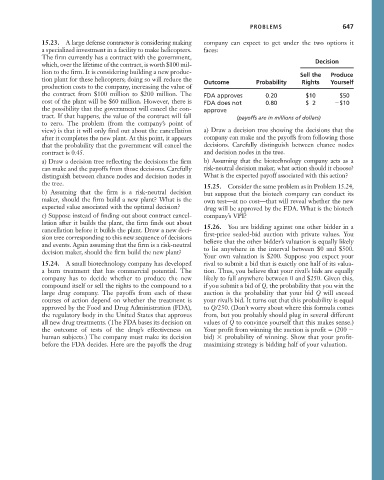Page 673 - Microeconomics, Fourth Edition
P. 673
c15riskandinformation.qxd 8/16/10 11:10 AM Page 647
PROBLEMS 647
15.23. A large defense contractor is considering making company can expect to get under the two options it
a specialized investment in a facility to make helicopters. faces:
The firm currently has a contract with the government,
which, over the lifetime of the contract, is worth $100 mil- Decision
lion to the firm. It is considering building a new produc- Sell the Produce
tion plant for these helicopters; doing so will reduce the Outcome Probability Rights Yourself
production costs to the company, increasing the value of
the contract from $100 million to $200 million. The FDA approves 0.20 $10 $50
cost of the plant will be $60 million. However, there is FDA does not 0.80 $ 2 $10
the possibility that the government will cancel the con- approve
tract. If that happens, the value of the contract will fall (payoffs are in millions of dollars)
to zero. The problem (from the company’s point of
view) is that it will only find out about the cancellation a) Draw a decision tree showing the decisions that the
after it completes the new plant. At this point, it appears company can make and the payoffs from following those
that the probability that the government will cancel the decisions. Carefully distinguish between chance nodes
contract is 0.45. and decision nodes in the tree.
a) Draw a decision tree reflecting the decisions the firm b) Assuming that the biotechnology company acts as a
can make and the payoffs from those decisions. Carefully risk-neutral decision maker, what action should it choose?
distinguish between chance nodes and decision nodes in What is the expected payoff associated with this action?
the tree.
15.25. Consider the same problem as in Problem 15.24,
b) Assuming that the firm is a risk-neutral decision but suppose that the biotech company can conduct its
maker, should the firm build a new plant? What is the own test—at no cost—that will reveal whether the new
expected value associated with the optimal decision? drug will be approved by the FDA. What is the biotech
c) Suppose instead of finding out about contract cancel- company’s VPI?
lation after it builds the plant, the firm finds out about
cancellation before it builds the plant. Draw a new deci- 15.26. You are bidding against one other bidder in a
sion tree corresponding to this new sequence of decisions first-price sealed-bid auction with private values. You
and events. Again assuming that the firm is a risk-neutral believe that the other bidder’s valuation is equally likely
decision maker, should the firm build the new plant? to lie anywhere in the interval between $0 and $500.
Your own valuation is $200. Suppose you expect your
15.24. A small biotechnology company has developed rival to submit a bid that is exactly one half of its valua-
a burn treatment that has commercial potential. The tion. Thus, you believe that your rival’s bids are equally
company has to decide whether to produce the new likely to fall anywhere between 0 and $250. Given this,
compound itself or sell the rights to the compound to a if you submit a bid of Q, the probability that you win the
large drug company. The payoffs from each of these auction is the probability that your bid Q will exceed
courses of action depend on whether the treatment is your rival’s bid. It turns out that this probability is equal
approved by the Food and Drug Administration (FDA), to Q/250. (Don’t worry about where this formula comes
the regulatory body in the United States that approves from, but you probably should plug in several different
all new drug treatments. (The FDA bases its decision on values of Q to convince yourself that this makes sense.)
the outcome of tests of the drug’s effectiveness on Your profit from winning the auction is profit (200
human subjects.) The company must make its decision bid) probability of winning. Show that your profit-
before the FDA decides. Here are the payoffs the drug maximizing strategy is bidding half of your valuation.

